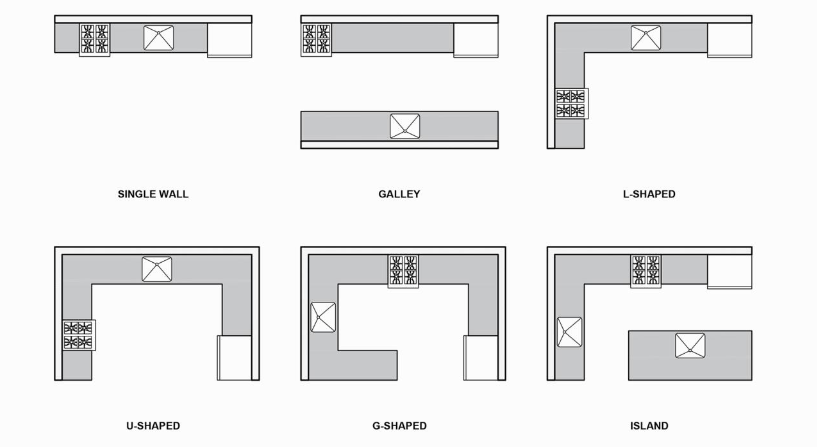In a previous article, we talked about the design principles used when arranging spaces in the kitchen. As much as we would all want a large and spacious kitchen that would allow us to design however we want, it’s quite often that we’re limited by the existing floor plan. How much space you have will dictate the layout. This is especially true in high-rise apartments, second-hand homes, and renovation projects. Worry not as we explore some of the most common layouts plus their various pros and cons.
Single Wall
The single wall is a layout most commonly found in studio flats and small apartments. They’re often found in such scenarios because it uses a minimum amount of space. Sometimes, that’s really all you can fit in a studio. But even if you don’t live in a micro-apartment, the single wall layout can still benefit you. Using only one wall allows for visual openness, which is great for open-plan homes. It’s easier to design because you don’t get those awkward corner cabinets. It’s also one of the least expensive options as you’ll naturally have fewer cabinets. Being on a single wall also allows for all utilities (i.e., plumbing, electrical, and ventilation) to be clustered together, which further helps bring down the costs.
The major downside is, of course, its size. Storage space can be lacking, and countertop space may be insufficient for your needs. You also can’t apply the kitchen triangle method here.
Galley
The galley kitchen puts cabinets and counters on two walls parallel to each other, creating an aisle in between. This is why it’s also called a “parallel kitchen” or “corridor kitchen”. It has many similarities with the single wall layout. They’re both commonly used in small apartments. They’re also typically less expensive than the other options here, and you also avoid corner cabinets. However, because you’re using two walls, you get more storage cabinets and countertop space compared to a single wall kitchen. Galley kitchens can be open on one or both of its ends. Having it open on two ends allows it to double as a passageway.
Again, the negatives come with a small footprint. Because the corridor tends to be narrow, it makes it difficult to have multiple cooks working at the same time. When the galley kitchen also doubles as a passageway, there’s a risk of having a lot of intersecting traffic in the kitchen –not the best thing to have from a safety standpoint. This, however, can be mitigated by keeping the major areas all on one side. Another downside is that this kitchen layout tends to have poor resale value especially if it’s used in a home large enough to accommodate other larger kitchen layouts.
L-Shaped
The L-shaped kitchen, as the name suggests, uses two walls perpendicular to each other to form an L shape. It’s commonly used in small to medium-sized homes. Compared to the two previous layouts, you have more countertop and cabinet space. This layout also opens up floor space, which can be used for a dining area or to add a kitchen island. This type of layout also lends itself well to the traditional kitchen triangle arrangement.
Unlike the two previous layouts, you will end up with a corner cabinet when using an L-shaped layout. Corner cabinets are often much deeper than the usual cabinets, and objects can be quite difficult to reach. Corners also tend to get less light, especially the lower corner cabinet. There are ways to deal with this, such as using lazy susans or spin-out shelves. Another caveat with L-shaped kitchens is that when you make them too long, especially on one side, the two endpoints of your kitchen triangle can become too far from each other. This would make it much less efficient to work in.
U-Shaped
The U-shaped kitchen makes use of three walls, or two walls with a connected island, to create its namesake shape. Another name it goes by is the “horseshoe kitchen”. You can think of it as similar to a galley kitchen, but adding a counter on one of the closed ends. The main draw to this layout is the amount of cabinet and countertop space you get. This shape is also one of the easiest ways to arrange the kitchen triangle –putting one end of the triangle on each wall. If the kitchen is big enough, it can easily accommodate multiple cooks at the same time. If one arm of your U shape is a peninsula, you can place seats on one side for a casual dining space.
Similar to the L-shaped kitchen, you run into issues with the corner cabinets. In general, using three walls also means that you use up more space, which may not be the best option for small homes. Putting a U-shaped kitchen in a small space can make the kitchen very cramped and difficult to move in. On the other hand, applying a U-shape in a very large space can result in your work areas being too far from each other.
G-Shaped
The G-shaped kitchen is taking the U shape a step further by adding a small connected island to the U. This layout is also sometimes called the “peninsula kitchen”. Because the peninsula can be accessed from 3 sides, it has a number of possible functions. Leave it blank and it can function as an extra prep counter. Having seats on the exterior side transforms it into a casual dining area. If you add a second sink or second cooking surface on it, you can have two work triangles in the kitchen.
Since the G-shaped kitchen is built upon the U-shaped layout, they share similar disadvantages.
Island
The island kitchen builds upon the previous layouts by adding a freestanding island counter. You can have a single wall with an island, making it function similar to a galley. You can also easily add an island to the L, U, and G shapes. This type of kitchen is best for large spaces, and often a popular choice for homes with a spacious open plan. It can make larger kitchens more efficient as it’s easier to designate zones in a larger space. Similar to the G-shaped kitchen’s peninsula, the additional island is versatile. You can have multiple work triangles, making it easier for multiple cooks. The island can also become an entertainment area for when you have guests. Your kids can also play and do their homework on the extra island countertop. The addition of an island can transform your kitchen into a very casual and social space.
As you may have noticed the trend with the other layouts, the major downside of this is the large space that it usually requires. Also, placing a stovetop or a sink on the island means a bit of extra cost. This is because getting ventilation or plumbing to the middle of the room is not as straightforward as having it along the wall. Having the kitchen as open and social space can also mean that it may sometimes get noisy while you’re working in the kitchen. If that’s a concern, you may want to opt for a more traditional enclosed kitchen setup instead.
Thank you for Visiting Wood and Co









